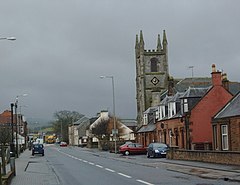New Cumnock
|
New Cumnock Scottish Gaelic Cumnag Nuadh |
||
|---|---|---|
| Buildings along the main street | ||
| Coordinates | 55 ° 24 ′ N , 4 ° 11 ′ W | |
|
|
||
| Residents | 2860 2011 census | |
| administration | ||
| Post town | CUMNOCK | |
| ZIP code section | KA18 | |
| prefix | 01290 | |
| Part of the country | Scotland | |
| Council area | East Ayrshire | |
| British Parliament | Ayr, Carrick, and Cumnock | |
| Scottish Parliament | Carrick, Cumnock and Doon Valley | |
New Cumnock ( Gaelic : Cumnag Nuadh ) is a village in the Scottish Council Area East Ayrshire and the capital of the Parish of the same name . It is located around seven kilometers south-east of the eponymous Cumnock and 48 km north-west of Dumfries in the south-east of East Ayrshire. Afton Water, coming from the south, flows into the Nith in New Cumnock .
history
New Cumnock's founding dates back to the late 17th century and is related to limestone mining. There have also been several pits in New Cumnock throughout history that have mined lead , antimony, and coal . On September 7, 1950, the New Cumnock mining disaster occurred when, after prolonged rainfall, the softened soil sagged into a tunnel in Knockshinnoch Castle Colliery and trapped 129 miners. 116 people were rescued after three days, while 13 died. The accident was the subject of the 1952 released film " The Brave Do not Cry " ( The Brave do not Cry ).
The last mine closed in the 1970s. However, the coal reserves in the area were not yet exhausted. In 2007, open-cast coal mining began at various locations. Among other things, a 13 km long conveyor belt was installed between the New Cumnocks loading station and a quarry in Dumfriesshire . After being nominated in 2009, the town was voted Scotland's Most Desolate Parish in 2013 and received the Carbuncle Award .
In the wake of the increasing demand for miners in the 19th century, the population of New Cumnocks rose from 2184 to 3781 between 1831 and 1881. Since 1951 (5508 inhabitants) the population has been steadily declining. It was most recently determined to be 2,860 in the 2011 census.
traffic
The A76 (Dumfries - Kilmarnock ) forms the main road New Cumnocks. As early as the 19th century, the Glasgow and South Western Railway New Cumnock connected to the railway network with a station along the Glasgow, Dumfries and Carlisle Railway . After the station was closed as part of the Beeching Ax in 1965, it was reopened in 1991. He is from the now Glasgow South Western Line of the First ScotRail operates.
See also
Web links
Individual evidence
- ^ List of Gaelic expressions
- ↑ a b c Entry in the Gazetteer for Scotland
- ↑ BBC: Mining disaster at Knockshinnoch Castle Colliery
- ↑ BBC News: Glenmuckloch coal road transport bid splits opinion , April 14, 2014.
- ↑ BBC News: New Cumnock wins Carbuncle award , March 28, 2013.
- ↑ Information. In: Gazetteer for Scotland. 2011.
- ↑ 2011 census
- ↑ RVJ Butt: The Directory of Railway Stations. Details every public and private passenger station, halt, platform and stopping place, past and present. Stephens, Sparkford 1995, ISBN 1-8526-0508-1 .
- ^ Cumnock, New. In: Francis H. Groome: Ordnance Gazetteer of Scotland: A Survey of Scottish Topography, Statistical, Biographical and Historical. Volume 2: (Cor - Edn). Thomas C. Jack, Grange Publishing Works, Edinburgh et al. 1884, pp. 327-328 .


